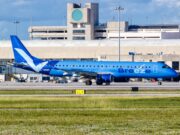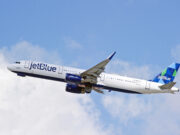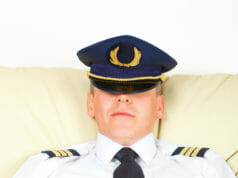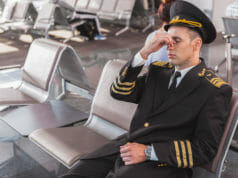Safety Matters
When thinking about flying in today’s world, most people just willingly book a ticket and hop on an airplane with the expectation that they will arrive safe and sound (and mostly on time) to their destinations. Many of those travelers even willingly, or begrudgingly, accept that the air travel is actually the safest form of transport on Earth that can quickly and efficiently take them to virtually any place in the world.
Unfortunately, that wasn’t always the case and aviation safety has definitely been an ever evolving process that strives for continuous improvement. This evolution has not only lead to aviation going from the least safe form of transport to the safest, but has also developed the technology that is now finding its way into other industries, such as the medical field, to improve safety and decrease risk where lives are also at stake.

Aviation Safety’s inauspicious beginning probably started on September 17, 1908 a mere four years and nine months after the Wright Brother’s first flight and only five months after the first passengers were carried by airplane. This less than momentous occasion also included the Wright Brothers when Orville Wright crashed with passenger Thomas Selfridge during a demonstration flight for the US Army. Wright was seriously injured and Selfridge was killed, leading to aviation’s first fatality. Of course, as aviation grew and more planes were built, more flights were conducted and more people began to push the boundaries of the technology, there were more accidents and more fatalities until eventually industry leaders believed that some form of oversight would be needed to help aviation really reach its full potential as a mainstream form of travel; as endless crashes would not be acceptable to the traveling public. This trend of increasing travel with an expectation for a decrease in accidents has continued to this day.
These circumstances lead to the establishment of the Bureau of Air Commerce in 1926 with the passing of the Air Commerce Act as a way to oversee regulation and promotion of air transport.
The first publicly popular safety incident was the death of Knute Rockne aboard a TWA Flight in 1931. Due to his high profile as Notre Dame’s football coach, the public demanded inquisition and information about what had happened. This importantly changed two major things that would determine the path of aviation safety forever. First, it changed the practice of keeping accident causes a secret. Second, it started the trend of using technology and design to improve the safety of airplanes. This was part of what prompted the move away from wood and fabric to aluminum as a main construction material.

The next watershed moment in aviation history was the fatal crash of Senator Bronson M. Cutting in 1935, which lead to the creation of the Civil Aeronautics Agency in 1938. The function of this change was to separate the regulation of air travel from the Department of Commerce, and to give the ability to regulate, investigate and ensure flight safety by giving the oversight of national airspace system, air traffic control to the Civil Aeronautics Agency and aviation safety regulation, oversight and economic control of airline routes to the Civil Aeronautics Board.
In 1956 with the mid-air over the Grand Canyon as a result of lack of radar, the regulators were again reorganized into today’s current FAA, which combined all regulatory, ATC, and Safety functions into one place (route regulation remained in effect until 1978 and investigation also remained independent).
With the modern regulatory framework established and consolidated, focus could turn to emerging technologies that could be used to enhance safety in an era of jet transport and massive worldwide expansion. The first of these was obviously the widespread integration of radar into the air transport system, which would safely ensure aircraft separation even during inclement weather.
It should be noted that up to this point in time, investigation was primarily based on an understanding of forensic evidence available to investigators, and in those cases where there were survivors and eye witnesses, information that could be provided by those people to help piece together the chain of events that lead to an accident. Of course this typically did little to answer the how and why of accident causal factors, not to mention contributing factors that may have played a role such as electrical failures, etc. This made it difficult to incorporate lessons into new technologies or ways of doing things once an accident was investigated. This lead to the next big push in safety, the Cockpit Voice Recorder and Flight Data Recorder which both became mandated in the US in 1967. For the first time ever, investigators had a first-hand look into the operating parameters of an airplane prior to the crash, as well as some insight into what the crew was doing, thinking, or saying during the accident events. This revolutionized air safety because it allowed investigators to glimpse details of the accident that might be able to be used to prevent future occurrences.
Of course, the now widespread usage of these technologies highlighted the fact that the vast majority of aviation accidents were related to human error. This rendered the next step also revolutionary for aviation safety. By identifying the details of the human role in aviation accidents safety professionals could, for the first time, identify trends and problems in human behavior and interaction and begin to educate and train pilots to work together to achieve the common goal of a safe flight. This was the birth of Cockpit Resource Management; later revised to Crew Resource Management (CRM) when it became apparent that “all resources” were not just limited to the flight deck. This technology alone had the single greatest benefit so far to improving the safety of aviation because it specifically taught personality and decision making norms that not only included everyone, but also got those crew members working with the same tools and technologies and improving coordination as a team.
By the mid-1990’s, CRM had more or less become a mature technology, it had been widely implemented, and was directly credited with avoiding or preventing many accidents or incidents that could have been far worse. However, CRM could only do so much toward preventing future accidents because it was still fundamentally being updated and improved based on events that had already happened and could not necessarily predict or prevent accidents that could happen in the future. In order to move safety to the next level, a system to prevent accidents would need to be developed.
In the late 1990’s the implementation of Flight Operations Quality Assurance, or FOQA, became the first push in a system that would be able to predict developing trends or problems. Essentially, computer technology had come to a point on most airplanes where it could actually keep track of data not just on accident or incident flights, but on the thousands of other flights that occurred between such flights. This allowed investigators, safety people, maintenance and flight ops personnel to download and track flight data over thousands of routine flights and monitor trend data such as unstable approaches, which could then be integrated into training, newsletters, policies, etc. In addition to the front line usage, it allowed the FAA to be able to identify problem trends with things such as structural design issues which in turn allowed them to make more effective rules and regulations regarding aircraft design and certification standards, airmen training requirements, etc.
Now that trend data could be readily identified, safety professionals realized that in order to get to the root causes behind the trends identified under FOQA, they needed to get first hand insight into the actions of crew members. As any aircrew member knows, no crew member will willingly trust divulging what mistakes they made or procedures they violated to management or the FAA knowing that they could be prosecuted or disciplined for it. In general, all successful safety programs require a system of openness and protection in order to get all parties to actually participate seriously. Of course there are exceptions for intentional and willful violations, but overall, the FAA, safety professionals, the airline flight departments and employee representatives sat down and designed the Aviation Safety Awareness Program, or ASAP system to encourage participation and protect those who report openly. In fact, open reporting actually has strict guidelines for protections that aren’t necessarily provided if someone fails to report. ASAP was eventually expanded to maintenance technicians, ground crew, flight attendants, dispatchers, ATC professionals, etc. to address trends in all areas of aviation.
Now that the aviation safety system was inclusive of all disciplines and constituents who openly reported and identified operational data, mistakes, challenges, violations or anything else of note, the safety system can finally evolve into a system that is able to actually identify accidents before they happen, which really is the end goal. The name of this system is a Safety Management System or SMS. SMS is a term that leaves most people saying “what?” but is essentially just a structured hierarchy to identify and classify trends, problems, changes, system issues, or any other problem that may require attention. It relies heavily on data and input from multiple data systems and reporting systems to help identify things that require attention either through training, policy, procedures or systems modification. It functions based on the reality that very seldom do accidents just happen. There are usually dozens if not hundreds of incidents prior to an accident that had similar symptoms, inputs or behaviors to the accident flight without actually resulting in an accident. By identifying these common links, safety people, flight ops and training people can preemptively employ tools to try and mitigate and reduce these occurrences before the accident ever occurs, and thus aviation has pro-actively become the safest form of transport the world has ever seen, despite flying higher further, faster and more often than ever before.
As always Our goal with this column is to provide an active way to participate in discussions about safety or safety related topics. Of course, reader input always helps that process, so we encourage you to send us emails at scott.stahl@aerocrewnews.com with any safety related questions or comments you may have, no matter how seemingly small they may be.

























































Dear Mr Scott Stahl,
I read your article The Evolution of Aviation Safety in @Aircrew News of 06 Dec 2016 and was delighted to have come across it accidently when I was researching the same subject. It is a very well researched and analysed article and I congratulate you for the same.
What I find really valuable is your focus on how certain important events evolved in to improvement of Flight Safety. I am an Aeronautical Engineer and worked in Aircraft Accident Investigation Board in the past, but never read such a beautiful account of evolution of Aviation Safety.
Thank you and would like to read more of your work.
Regards,
Gp Capt (Retd) DilipDani
Dear Scott Stahl,
I hope this comment finds you well. My name is Abdalla Sudi, and I am currently working on my master’s thesis focusing on aviation safety. I have come across your expertise in this field and was hoping to seek your guidance and insights.
Specifically, I am interested in the following areas:
1. The historical development of aviation safety
2. The evolution of aviation safety. like Technical factors, Human factors, orgaizational factors, safety culture, safety 1, safety 2. also systamatic approach Annex- 19 – 2013.
3. How aviation safety has evolved over time
Your expertise in aviation safety is highly regarded, and any information or insights you could provide would be immensely valuable to my research. Additionally, if you could recommend or share any relevant articles or resources related to these topics, it would be greatly appreciated.
Thank you very much for considering my request. Your assistance would significantly contribute to the success of my thesis. I look forward to hearing from you.
Sincerely,
Sultan Abdalla